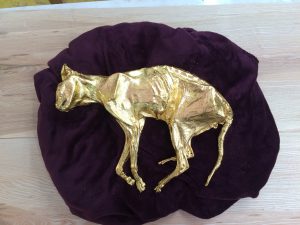A student who graduated earlier this year is shortly to fashion new legs for a 2,000-year-old terracotta horse.
Dr Phillip Prager from Luxembourg, a former assistant professor of aesthetics at the IT University in Copenhagen and a published expert on the nature of creative thinking, is a collector of the eclectic and unusual.
The legless horse dates back to the Han dynasty, which ruled China for four centuries until 220AD, a period which saw flourishing wealth and innovation – including paper-making, the invention of the compass and glazed pottery.
The pinnacle of Han pottery is held at the Museum of Terracotta Warriors and Horses of the Han Dynasty in Xuzhou. Excavated in 1984, it is the only terracotta army of the Han Dynasty found in China.
Earlier this year Phillip used his considerable skills to restore a medieval mummified cat, making a feline prosthetic tail from a strip of leather and gilding the entire cat in 24 carat gold, giving it an afterlife of great splendour.

The cat had been bricked up inside a wall of a medieval English house – a common practice to ward off evil spirits, and found during restoration work.
Phillip is staying on in Scotland and has bought an 18th century coach house just outside Haddington which he’s slowly filling with a fantastic mixture of the old, the quirky and the very quirky indeed.
His plan is to open part of his house to the public late next year, and to sell a variety of “curiosities” from a small shop at the front of his home – including furniture designed by himself and other students of the Chippendale School.
Phillip has also recently acquired two further mummified cats dating from the 19th century, discovered in the chimney of an ancient inglenook fireplace, now a gastropub in West Sussex,
His next project is to make a vanity table with a difference, incorporating some artifacts dating back hundreds of years, and others dating back thousands of years.
We’ll bring more news soon!
